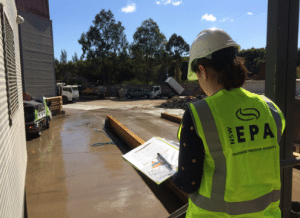Understanding the NSW EPA Regulatory System
The EPA (Environment Protection Authority) is the primary environmental regulator for New South Wales. The purpose of the EPA is to work with the government, businesses, and the community to reduce pollution and waste, prevent environmental degradation, and protect human health.
NSW companies which do not comply with the regulations of the EPA can be issued hefty fines and face prosecution, so it is important to understand how the EPA regulatory system works, how to stay in compliance with the current regulations, and the consequences of non-compliance. This guide is based on the Environment Protection Authority Compliance Policy (2013), which can be read in full here.

The EPA Regulatory System
The regulatory system of the EPA is risk-based, meaning that the authority makes decisions based on identifying the biggest risks to the Australian environment and health, and targeting those businesses and individuals whose activities are exacerbating that risk. The EPA takes certain factors into consideration when assessing environmental risk, including the environmental media involved, such as chemicals, waste, or air/odour/water emissions, the sensitivity of the local environment, the compliance history of the individual or company involved, and the processes which are having an adverse impact on the environment, as well as the current controls in place to mitigate these impacts.
The regulatory system of the EPA comprises four main elements: legislation, policy and programs; administrative systems; information and accountability systems; and compliance and enforcement actions. These four elements enforce and inform each other within the system, continually improving the communication between the EPA and its partners in the community, government, and business sectors.
To ensure compliance with its regulations, the EPA uses tools such as information and compliance assistance, where the EPA provides information to promote understanding of its regulations and encourage voluntary compliance, as well as economic incentives and various compliance actions ranging from audits to penalty notices.
How the EPA Monitors Compliance
The EPA uses a range of mechanisms to monitor the compliance of individuals and businesses with their regulations:
-
- Community reports: The EPA has a dedicated “Environmental Line” phone line which members of the public can use to report pollution incidents and other environmental concerns. All reports are followed up by EPA staff.
-
- Information from other regulatory authorities: Officers from other regulatory authorities can also detect breaches in regulatory requirements and share their information with the EPA.
-
- Industry accountability and monitoring provisions: The EPA requires all environment protection licensees to submit a legally binding annual compliance statement detailing their compliance over the previous reporting period. The POEO Act (1997) also requires that employers report any pollution incidents to the EPA and other relevant authorities. This ensures that the incident is managed effectively and local communities are duly informed about any resulting health or environmental impacts.To familiarise yourself with how to handle a pollution incident at your facility, see our blog post discussing the correct emergency spill response procedure.
-
- Inspections and campaigns: The EPA can undertake unannounced routine site inspections to collect information and samples, view records, take photographs, and monitor compliance. Regular campaigns are also used to assess compliance, and raise awareness about EPA requirements.
-
- Audits: The EPA assesses compliance and performance using several types of audits, including compliance audits by EPA officers, mandatory environmental audits conducted by a third party, and statewide strategic environmental compliance and performance reviews.
- Investigations: When there is a reported or detected incident of alleged environmental harm or other breach of legislation, authorised EPA officers conduct an investigation. During an investigation, the EPA gathers evidence including photographs, videos, samples, witness statements, and records of interviews to establish the severity of the offence, the responsible parties, and determine the need for further enforcement action.
The Consequences of Non-Compliance
When a breach in regulation is identified, the EPA evaluates the significance of the non-compliance in order to determine the most appropriate action. This includes the risk posed to the environment by the breach, and whether the breach was deliberate, opportunistic, or unintentional on the part of the offender.
When choosing the appropriate enforcement action, the EPA considers multiple factors including the severity of the breach or incident, the level of cooperation with the EPA by the offender, the compliance history of the offender, public interest and community expectation in the action to ensure deterrence, statutory time limits for taking action, legislative procedures and policy requirements, and the potential or actual harm caused to the environment by the incident.
The compliance and enforcement methods which the EPA uses includes:
-
- Advisory letters
-
- Formal warnings
-
- Show cause letters
-
- Official cautions
-
- Pollution reduction programs
-
- Variations, suspensions and cancellations of regulatory instruments
-
- Notices, directions and orders, including clean-up notices, prevention notices, compliance notices, and notices to recover the cost of human health and environmental risk analysis
-
- Mandatory environmental audits
-
- Penalty notices
-
- Enforceable undertakings
- Prosecutions, with a number of sentencing options including custodial sentences, offences, fines, environmental audits, environmental service orders, and paying the monetary benefit gained from the offence
SpillShop stocks a variety of quality spill response and liquid containment products which will help you stay in compliance with current EPA regulations, including spill kits, absorbents, granules, bunding and drain protection. For more information, you can visit our FAQ page or Contact Us directly to discuss your needs.
Image: Twitter


